Tissues Vet. Anatomy and Physiology – Flashcards
Unlock all answers in this set
Unlock answersquestion
Tissue
answer
groups of cells that have specialized structural and functional roles
question
Epithelial tissue
answer
covers organs, lines the inside of body cavities and hollow organs
question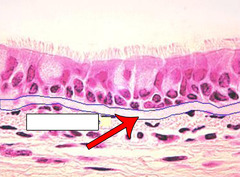
Basement membrane

answer
thin, nonliving layer that attaches epithelial tissue to connective tissue
question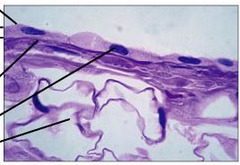
Simple squamous epithelium

answer
single layer, reduces friction, in the inner lining of the lung, the filtration membrane of the kidneys, lining of the chest and abdominal cavities, lining blood and lymphatic vessels
question
Simple cuboidal epithelium
answer
single layer of cube-shaped cells with central, spherical nuclei, found where secretion and absorption take place: on the surface of the ovaries; in the secretory portions of glands (thyroid); lining of the ducts of the liver, pancreas, kidney, and salivary glands
question
Simple columnar epithelium
answer
single layer of elongated cells with nuclei located near the basement membrane, Line the length of the gastrointestinal tract from the stomach to the rectum
question
Pseudostratified columnar epithelium
answer
found in some areas of the respiratory system and the male reproductive tract
question
stratified squamous epithelium
answer
many layers of flattened cells, Found in regions of the body that are subject to mechanical and chemical stresses (lining of the mouth, esophagus, vagina, rectum; epidermis)
question
stratified cuboidal epithelium
answer
two or three layers of cuboidal cells that form the lining of a lumen, Found primarily along large excretory ducts (sweat glands, mammary glands, salivary glands)
question
stratified columnar epithelium
answer
several layers of elongated cells, rare, Found in select parts of the respiratory, digestive, and reproductive systems and along some excretory ducts
question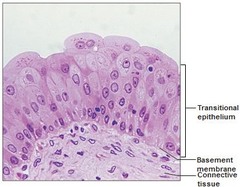
transitional epithelium

answer
specialized to change in response to increased tension, found in the urinary bladder, ureters, urethra, calyxes of the kidney
question
glandular epithelium
answer
cells that are specialized to produce and secrete substances into ducts or into body fluids, Have prominent endoplasmic reticulum, Golgi apparatus, and secretory granules
question
exocrine gland
answer
glands that secrete products into ducts that open onto some internal or external surface
question
endocrine gland
answer
glands that secrete their products into tissue fluid or blood
question
merocrine gland
answer
glands that release watery, protein-rich fluids by exocytosis
question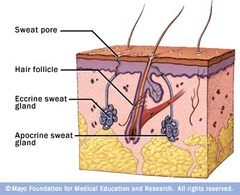
apocrine gland

answer
glands that lose small portions of their glandular cell bodies during secretion
question
holocrine gland
answer
glands in which the entire cell lyses during secretion
question
connective tissue
answer
composed of non-living extra-cellular matrix, provides structural and nutritional support, vascularized, blood, bone, cartilage
question
matrix
answer
intercellular material consisting of fibers and a ground substance whose consistency varies from fluid to semisolid to solid
question
fibroblasts
answer
large, star-shaped fixed cells, manufacture and secrete both the fibers and the ground substance of their matrix
question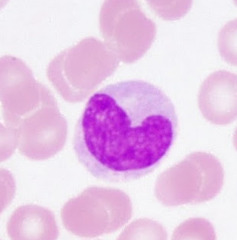
macrophages

answer
originate as white blood cells; specialized to carry on phagocytosis; function as a scavenger and defensive cell that clears foreign particles from tissue
question
collagenous fiber
answer
composed of collagen, tremendous tensile strength, found in tendons and ligaments
question
elastic fiber
answer
composed of elastin protein; thin, branching fibers that form complex networks; branched, but lack tensile strength; found in the vocal cords, lungs, skin, and walls of blood vessels
question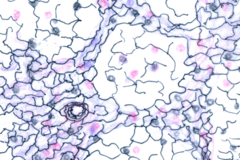
reticular fiber

answer
very thin collagenous fibers that are highly branched and form delicate support networks
question
areolar tissue
answer
delicate, thin membranes made mostly of fibroblasts
question
adipose tissue
answer
connective tissue that develops when certain cells store fat in their cytoplasm
question
dense fibrous connective tissue
answer
a densely packed arrangement of collagen fibers (proper)
question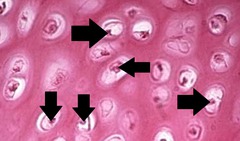
chondrocytes

answer
cartilage cells
question
hyaline cartilage
answer
very fine collagenous fibers in its matrix; found on the ends of bones, soft part of nose, supporting rings of respiratory passages (specialized)
question
elastic cartilage
answer
dense network of elastic fibers; provides framework for external ears and larynx (specialized)
question
fibrocartilage
answer
very tough tissue with many collagenous fibers; shock absorber for vertebrae, knees, pelvic girdle (specialized)
question
blood

answer
transports materials between interior body cells and those that exchange substances with the external environment (specialized)
question
skeletal muscle tissue
answer
long, threadlike cells with light and dark striations and many nuclei located just below the cell membrane; found in muscles that attach to bones and can be controlled by conscious thought
question
smooth muscle tissue
answer
spindle-shaped cells with a single, central nucleus that lack striations; actions are involuntary
question
cardiac muscle tissue
answer
striated cells joined end-to-end at intercalated discs; found only in the heart
question
nervous tissue
answer
tissue found in the brain, spinal cord, and peripheral nerves
question
neurons
answer
nerve cell; sense changes in their surroundings and respond by transmitting impulses along cytoplasmic extensions to other neurons, muscles, or glands
question
Junctional Complex
answer
The point at which epithelial cells join to one another in very close proximity; gives epithelial tissue strength
question
Tight Junctions
answer
fusion of the outermost layers of the plasma membranes, found in tissues that cannot leak, such as the urinary bladder and digestive tract
question
Desmosomes
answer
strong welded plaque or thickening, mechanical coupling formed by filaments that interlock with one another, Found in tissues that undergo repeated episodes of tension and stretching, such as the skin, heart, and uterus
question
Hemidesmosomes
answer
link epithelial cells to the basement membrane
question
Gap Junctions
answer
Linked by tubular channel proteins called connexons, found in intestinal epithelial cells, the heart, and smooth muscle tissue
question
Microvilli
answer
Fingerlike projections that cover the epithelial cell, increase the surface area of the cell
question
Cilia
answer
Tiny hairs that cover the free surface of the epithelial cell, found in the respiratory tract
question
Mesothelium
answer
epithelium that lines the pleural (chest), pericardial (around the heart), and peritoneal (abdominal) cavities
question
Endothelium
answer
epithelium that lines the blood and lymphatic vessels
question
Absorptive cell
answer
apical surface is covered by microvilli that maximize absorption
question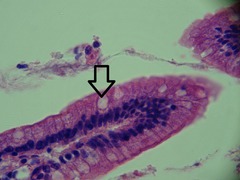
Goblet cell

answer
manufacture and store lubricating mucus that is secreted onto the luminal surfaces of the epithelia
question
Serous secretions
answer
watery and contain a high concentration of enzymes
question
Mucous
answer
thick and viscous and are composed of glycoproteins
question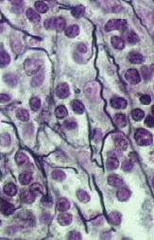
Reticular Cells

answer
flat, star-shaped cells with long, out-reaching arms that touch other cells, forming netlike connections throughout the tissue; involved in the immune response; found in lymph nodes, spleen and bone marrow
question
Mast Cells
answer
oval cells that have large numbers of dark-staining granules, containing histamine and heparin, stored in the cytoplasm
question
Macrophages (Kupffer Cells)
answer
in the liver
question
Macrophages (Microglial Cells)
answer
in the brain
question
Macrophages (Histiocytes)
answer
in loose connective tissue
question
Reticular Connective Tissue
answer
Forms a network called a stroma which constitutes the framework of several organs
question
Dense Regular Connective Tissue
answer
Composed of tightly packed, parallel collagen fibers, found in tendons and ligaments (proper)
question
Dense Irregular Connective Tissue
answer
Composed of collagen fibers that are arranged in thick bundles, found in the dermis of the skin and in fibrous coverings of the kidney, testes, liver and spleen (proper)
question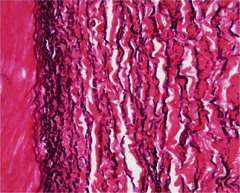
Elastic Connective Tissue

answer
Yellow fibers arranged in parallel or in an interwoven pattern with fibroblasts and collagenous fibers interspersed, in the spaces between vertebrae and in the walls of arteries, stomach, bronchi, bladder and areas of the heart (proper)
question
Bone

answer
Hardest and most rigid connective tissue (specialized)
question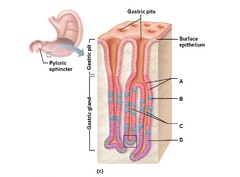
Mucous membranes

answer
found lining the organs that have connections to the outside environment
question
Serous membranes
answer
Line the walls and cover the organs that fill closed body cavities
question
Parietal layer
answer
portion of the membrane that lines the cavity wall
question
Visceral layer
answer
portion of the membrane that covers the outer surfaces of the organs
question
Cutaneous membranes
answer
skin
question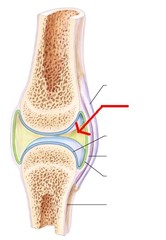
Synovial membranes

answer
line the cavities of joints
question
Inflammation

answer
initial response to injury, heat, swelling, redness, pain, loss of function
question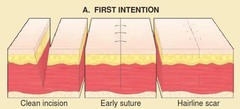
First Intention Healing

answer
Skin forms a primary union without the formation of granulation tissue or significant scarring
question
Second Intention Healing
answer
Occurs in wounds in which the edges are separated from one other, in which granulation tissue forms to close the gap, and in which scarring results



